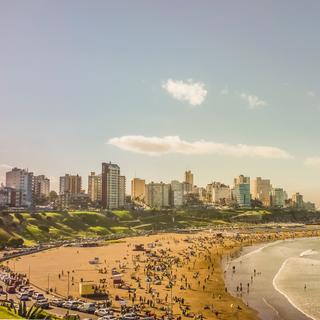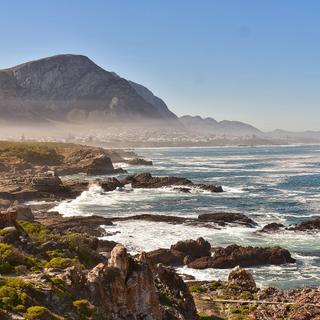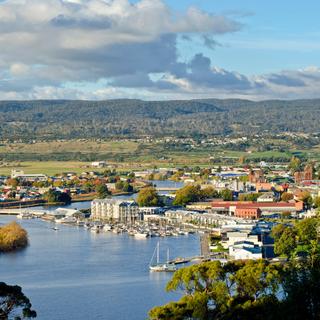
Hobart weather and climate in 2025

Hobart weather and climate in 2025
Day
12 °C
Night
4 °C
Sea
13 °C
Precipitation
56 mm
in month
Rainy days
11 days
in month
Daylight
9 hours
average
Sunshine
4 hours
average
Humidity
73 %
Weather charts for Hobart
Find more destinations like this
Destinations with similar weather to Hobart
Other destinations in Tasmania - Australia
Closest cities for Hobart
Last week's weather in Hobart
The week of 23 June 2025 - 29 June 2025 had an average daily temperature of 14 °C (57 °F) and a minimum (nighttime) temperature of 5 °C (41 °F). Both the daily and night temperatures in Hobart are roughly same as the long-term average, which is around 13 °C (55 °F) and 4 °C (39 °F) respectively. Wednesday marked the coldest day of the week. The average temperatures during different times of day (local time) were following: 7am 7 °C (45 °F), 10am 11 °C (52 °F), 1pm 13 °C (55 °F), 4pm 10 °C (50 °F), 7pm 9 °C (48 °F), 10pm 7 °C (45 °F).
During this week: 4 days without rain and 3 days with light rain were observed. During the whole week, total of 9 mm (0.35 in) of precipitation was observed, which is roughly same as the long term average for Hobart, which is 12 mm (0.47 in). From dawn to dusk, there was an average of 56 % cloud coverage during the day.
An average wind speed of 4.7 m/s was recorded. The most common wind direction(s) were North-West and North. The air pressure varied between 984 hpa and 1030 hpa. On average, the air humidity in Hobart was 80 %.
On average, there were 3� hours clear skies, 3 hours partially overcast skies and 4 hours overcast skies during the daytime (from dawn to dusk). On average, the time of sunrise was 07:42, and the time of sunset was 16:44.
Weather overview for Hobart
Weather overview
Hobart (Australia) in general has a hot climate. Temperatures during the day are in the range from 12 °C (54 °F) in July to 22 °C (72 °F) in January. Temperatures during the night go from 4 °C (39 °F) in July to 11 °C (53 °F) in January. The least rainy month in Hobart is February with its 8 days of rain, the rainiest month is September, when it rains 13 days.
January weather
The tourist season is taking place in Hobart. The day temperature is on its maximum, its value is 22 °C (72 °F), and the maximum of the night temperature is observable as well, its value is 11 °C (53 °F). The descent of the number of rainy days can be observed, the value of this measure is 8 days. The number of sun hours (without clouds) is on its maximum in this month.
February weather
The tourist season is taking place this month in Hobart. The minimum of the number of rainy days can be noticed, the value of this measure is 8 days, while the rainfall amount descents similarly to the previous month, with its value being 41 mm (1.60 in). The number of sun hours (without clouds) starts to descent in February.
March weather
The beginning of the descent of the day temperature could be noticed, with its value being 21 °C (69 °F) in Hobart, and the beginning of the descent of the night temperature could be noticed as well, with its value being 10 °C (50 °F). The number of rainy days rise's start could be observed, with its value of 9 days. The tourist season continues. The number of sun hours (without clouds) descents similarly to the previous month, the value of this measure is 6 hours.
April weather
The tourist season is taking place in Hobart. The descent of the day temperature can be observed, with its value being 18 °C (64 °F), and the night temperature continues to descent as well, the value of this measure is 8 °C (47 °F). The descent of the number of sun hours (without clouds) can be observed, with its value being 5 hours. The number of rainy days continues to rise, the value of this measure is 10 days.
May weather
The day temperature continues to descent, with its value being 15 °C (59 °F) in Hobart, and the night temperature continues to descent too. The rainfall amount is on its minimum, the value of this measure is 40 mm (1.56 in). The number of sun hours (without clouds) descents similarly to the previous month, its value is 4 hours. The wind speed reaches its minimum.
June weather
The day temperature descents similarly to the previous month in Hobart. The rainfall amount rise's start could be observed, and the number of rainy days starts to rise too, with its value being 10 days. The number of sun hours (without clouds) is on its minimum in this month. The maximum of the humidity is observable, with its value of 73 %.
July weather
The rise of the number of rainy days can be observed, its value is 11 days in Hobart, and the rainfall amount continues to rise too, with its value being 56 mm (2.21 in). The minimum of the day temperature can be noticed, the value of this measure is 12 °C (54 °F), and the minimum of the night temperature can be noticed as well in July. The number of sun hours (without clouds) starts to rise in this month.
August weather
The day temperature starts to rise, with its value of 14 °C (56 °F) in Hobart, and the night temperature rise's start could be observed too in this month. The number of rainy days continues to rise, with its value being 12 days, while the rainfall amount is on its maximum, the value of this measure is 67 mm (2.63 in). The rise of the number of sun hours (without clouds) can be observed, the value of this measure is 5 hours.
September weather
The day temperature continues to rise, with its value being 15 °C (60 °F) in Hobart, and the night temperature rises similarly to the previous month too, its value is 6 °C (42 °F). The beginning of the descent of the rainfall amount could be noticed, with its value of 60 mm (2.35 in), while the number of rainy days is on its maximum in this month. The number of sun hours (without clouds) continues to rise.
October weather
The night temperature rises similarly to the previous month, the value of this measure is 7 �°C (45 °F) in Hobart, and the day temperature continues to rise too, with its value of 17 °C (63 °F). The rise of the number of sun hours (without clouds) can be observed, with its value of 6 hours.
November weather
The tourist season slowly starts this month in Hobart. The rise of the day temperature can be observed, with its value of 19 °C (66 °F), and the night temperature continues to rise as well, with its value of 9 °C (47 °F). The number of rainy days starts to descent, its value is 11 days, and the rainfall amount starts to descent too in November.
December weather
The day temperature rises similarly to the previous month, its value is 21 °C (69 °F) in Hobart, and the rise of the night temperature can be observed as well, with its value of 10 °C (50 °F). There is pending tourist season in December. The rainfall amount starts to rise, while the descent of the number of rainy days can be observed, its value is 10 days.
FAQs
Is January part of the wet season in Hobart?
No, there is no wet season in January in Hobart - you can expect 8 days of rain during the month.
What is the temperature in Hobart during the day in February?
The average daily temperature in Hobart in February is 22 °C (72 °F). A comfortable temperature for most people, where it is neither too cold nor too hot, and a large number of activities can be carried out comfortably, including sunbathing by the water. Lighter clothing will be suitable - shorts, skirts, t-shirts, jackets; a light sweater and long trousers may also be useful.
What is the night temperature in March in Hobart?
The average night temperature in March in Hobart is 10 °C (50 °F). The nights will be cool, layers of clothes will be needed for evening and morning walks, the hotel should be equipped with heating.
Are there good conditions to visit in April in Hobart?
There are good conditions for visiting in April in Hobart. You can expect just 10 days of rain during the month, taking an umbrella is not necessary. A relatively low temperature of 18 °C (64 °F) may be ideal for walking or outdoor activities, but some people may have a different idea of the holiday. The temperature of 8 °C (47 °F) at night may make it better to dine inside or to put on more clothes for a dinner outside.
How windy is it in Hobart in July?
An average wind scale that can be expected in July in Hobart is 5.
Is August part of the dry season in Hobart?
No, August is not a dry month in Hobart, expect rain approximately 12 days in a month.
What level of humidity is to expect in September in Hobart?
In September in Hobart, expect humidity around 62 %.
How many sunny hours can I expect in October in Hobart?
There is an average length of sunshine of 6 hours per day in October in Hobart.
What is the average number of rainy days in November in Hobart?
In November in Hobart, we can expect 11 days to be rainy, that is, days when precipitation exceeds 2 mm (0.08 in). Converted to days of the week, this means that it will occur on an average of 2.6 days of the week, or in general - 36 % days.
What is the sea temperature in December in Hobart?
The sea will reach 14 °C (58 °F) in December in Hobart. This is a sea temperature for resilient people only, most people won't enjoy swimming in such cold water or will have to use a wetsuit for water activities.




